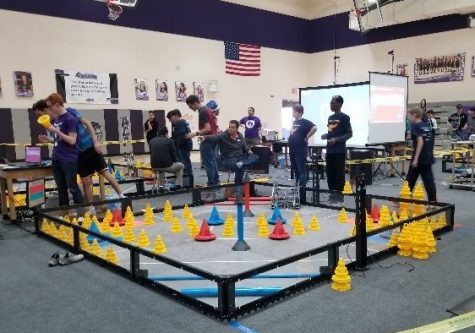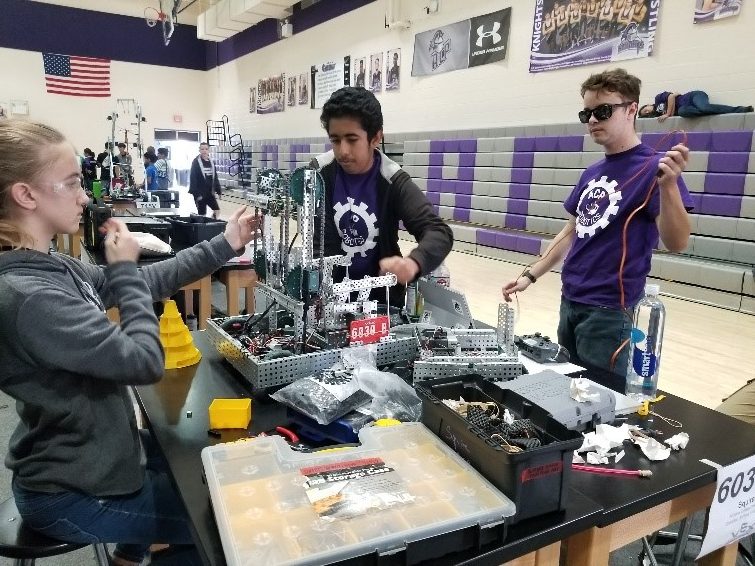A Look at ACP’s Robotics Program
Tyler Jiemback fills me in on the 2017-18 season of ACP Robotics.
February 1, 2018
ACP’s robotics teams has historically the strongest program on our school’s campus. They consistently find themselves near the top of the VEX rankings and have been invited to the VEX Robotics World Championships on several occasions. This past weekend, ACP hosted a competition for the first time this school year. I had the opportunity yesterday to sit down at chat with one of their leaders, senior Tyler Jiemback, about how VEX works, the season to date, and Saturday’s competition.
How does ACP Robotics work?
Nate: Starting two years ago, ACP began to offer a robotics class. What does this class consist of?
Tyler: The robotics class was created in order to give people in the club more time to work, but it’s also there to get people interested in robotics. We have two non-competition teams that students in the robotics class work on. They still do the same [VEX] game and build robots to complete the task, but they don’t go to competitions due to the high entry fees. They don’t compete, but they still get a good feel for robotics and scrimmage with our [competition teams] throughout the year.
Nate: How many competition teams are there?
Tyler: There are three: Knights, Squires, and Jesters. The Squires are our junior-high-only competition team and are led by Nik Pearce and Sophia Chan. There are also the Knights and Jesters, made up of high school students this year. I lead the Knights, and Elaina Ashton leads the Jesters.

Nate: Could you walk me through a typical season? What are the typical steps from the beginning of the year and on?
Tyler: The first thing we always have to do is decide who’s on what team. After that, we get together and break down the game, figure out the best strategies for scoring points, and start designing a robot specifically-geared toward winning the competition. For example, this year’s competition features stacking cones and moving mobile goals. Mobile goals score more points, so we started our design process off by trying to figure out how to lift and score those.
Nate: About how long do you guys spend in this design process?
Tyler: The initial design process takes around a week to two depending on how complicated the game is for a given year. After that, the design process is ongoing based off of how testing goes, how competitions go, and what we see in other robots.
The 2017-18 Robotics Season
Every year, VEX Robotics creates a new game that the teams will play during competitions throughout the year. This season’s is called “In The Zone,” where points are scored by stacking cones and moving mobile goals into certain sections of the field. Each match begins with a 15-second autonomous period where the robot moves based solely on what the team has pre-programmed into it. The driver has no control. This is followed by 1 minute, 45 seconds of driving, in which the teams try to accumulate as many points as possible. A video of a match in Maryland can be found below. They are much more fast-moving than I expected!
Nate: How many competitions have you guys had this season?
Tyler: Before the ACP one, we had four others.
Nate: How have those gone, has it been a successful season?
Tyler: It’s been successful. Not in the typical sense of winning a lot, but it’s been a lot more about teaching the next group of people how to create a high-performing, well-thought-out robot. This year was more of a training year than a qualifying-for-Worlds-year. In the next few years, there will be big things happening.
Nate: What is ACP’s strategy in matches? One robot on defense and one on offense?
Tyler: This year, we initially wanted to take on a defensive strategy, but closer examination of the rules made that very difficult. You can’t really accumulate scoring objects… and that makes it difficult to execute any type of hoarding strategy. The game is a lot more physical this year, which brings up worries about structural integrity and how that will affect the robot long term. Parts are expensive and not easy to come by.
Nate: Aw, so you can’t just go and ram other people’s robots? Probably would make some other teams unhappy.
Tyler: Actually, we did do that a couple times. We have an autonomous program where we just drive straight across the field to get in the path of the opponent’s autonomous to prevent them from scoring. We’ve had a lot of success with that, it really messes them up. On Saturday, one of our issues was that our wireless link-up, which is plugged in via USB, was dislodged right at the beginning of the match, so we couldn’t operate the robot at all during the match. This resulted in us losing, but it also brings up less-thought-of problems, allowing us to go back and analyze them, figure out how to fix that problem and others like it.
Saturday’s Tournament
A total of 27 teams came to ACP’s tournament last Saturday, a very impressive turnout. In VEX Tournaments, the day starts with qualification matches, followed by the elimination rounds in the afternoon. The Knights team made it to the quarterfinals, losing 2-1 to their opponent. Saturday’s tournament was not without controversy.

Nate: What are a couple problems you guys faced?
Tyler: This year’s competition was with a lot of middle-school teams, and with that comes a lot less experience with the rules. In our pool, we had a team that took the opponents’ scoring object and scored it in our zone. Fortunately it wasn’t match-affecting, but it was quite the debacle and there were quite a few angry parents.
Nate: Ooo, angry robotics parents! I’d never thought of that before.
Tyler: Yeah, it gets quite heated.
The robotics teams have their next tournament this upcoming Saturday out at Willis Junior High. If you’re looking for something different to do, go check out a robotics match!
